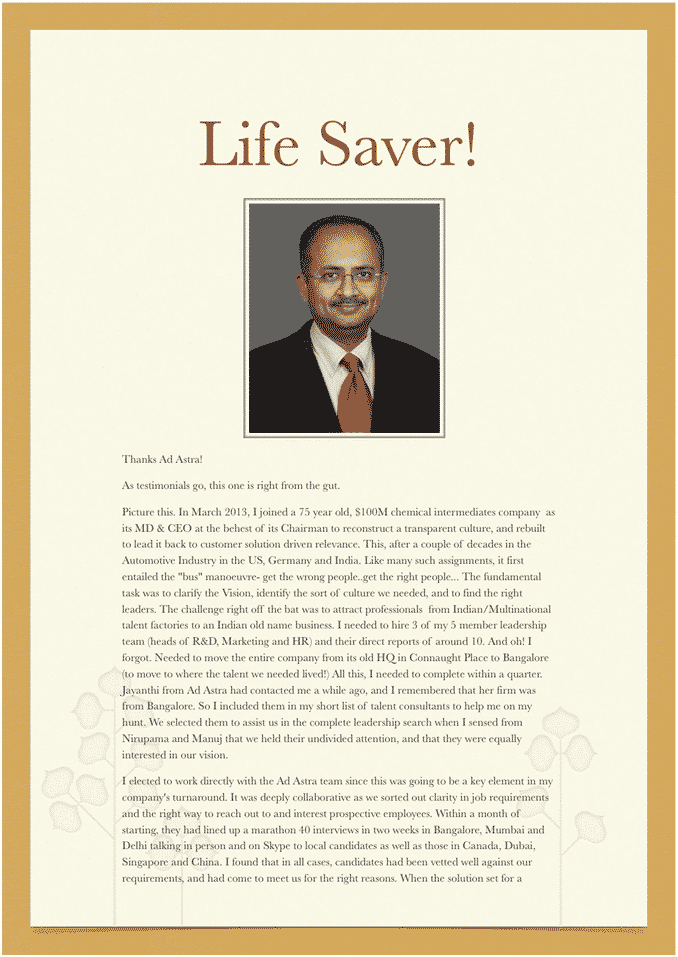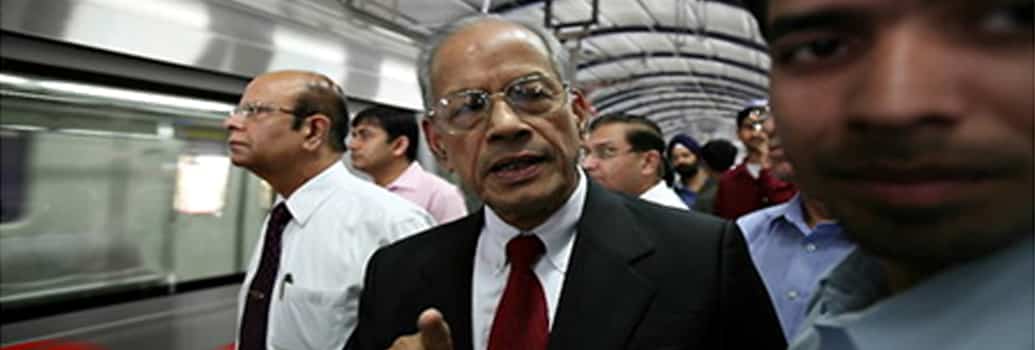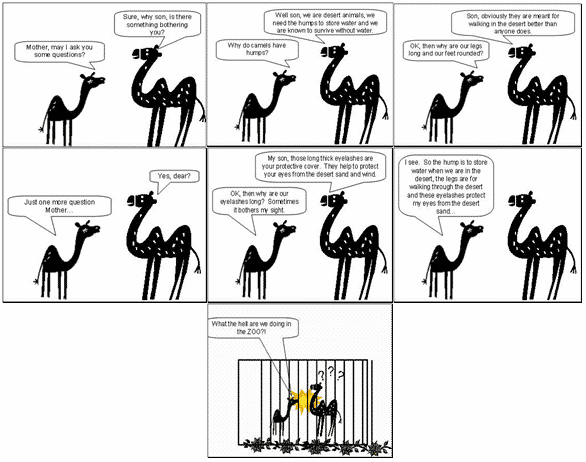Author: adastra
Hire the best
Hire the best
Hr Metrics
pdf slider6
Manuj Bij
Manuj Bij has over two decades of experience in the talent search and staffing industry, and has been successful in placing CXO talents in industries like FMCG, Automobile, Consumer Durable, Telecom, Heavy Manufacturing, Chemical and Infrastructure. He has successfully executed multiple RPOs and Project Hirings, for various multinationals and large Indian corporations. He currently heads the northern region operations for Ad Astra. He enjoys networking and creating high-performance teams while being adept at key Account Management and Business Development. He is a commerce graduate and MBA by qualification.
Bikram Basu
Bikram Basu is the head of Business Development of the western region, he has experience in various areas like sales, marketing, consulting and business development. Before moving to Consulting 10 years before, he has had 15 years of experience in training, logistics and telecom. In Ad Astra, as a part of the Strategy Team, he works on the acquisition and mining of National Strategic Accounts, utilising his expertise in research. He is a Post Graduate Diploma in Business Management from NIS Sparta, India.
Sourav Bose
Sourav Bose, the co-founder of Ad Astra, completed his MBA from Burdwan University, India. Coupled with over two decades of experience in Business Development and Recruitment Consulting, which has made him an expert in Turnkey Project Management. He has helped various companies set up their operations in the eastern region of India. He believes in a focused approach and continuous investment to enhance operational and delivery standards. He specialises in the implementation of global best practices along with a blend of technology and CRM. In his stint before Ad Astra, he built the entire business of a large recruitment firm, which made the company one of the top 3 firms in a span of 1 year.
Nirupama V.G.
Nirupama V G is the Managing Director and mastermind behind Ad Astra, she comes with a 25-year experience in HR, Business Development, and Recruitment Consulting. As part of the Management Team, Nirupama has co-founded 3 of India’s largest HR Consulting firms which were later acquired by Multinational HR firms. She has been an integral part of many Multinational companies successfully setting up their operations and has been driving successful service delivery in some of the toughest industries. She is revered as a Thought Leader in the HR Consulting and Recruitment Industry in India. She has also served on the Executive Council of Executive Recruiters Association and is a Career Mentor with Monster– the world’s largest job portal. She holds an MBA in HR from NIPM, India.
Find Job Slider 1
THE BIG STEP TO YOUR GREAT CAREER STARTS HERE
REGISTER NOW
pdf slider5
pdf slider4
pdf slider3
pdf slider2
pdf slider
Slider 3
Full suite bespoke solutionsfor a wide range of organisations
Slider 2
Accelerating businessthrough technology usingAI and Machine Learning
Slider 1
Ad Astra gets global recognition from Oxford Economics, a world leader in forecasting and quantitative analysis
Bangalore, June 30, 2018: Ad Astra, one of the largest full-suite recruitment service providers in India, has received global recognition for getting its case study published in ‘The American Express Global SME Pulse 2018’, conducted by Oxford Economics.
The report titled ‘SME Pulse 2018 – Strategies for Sustainable Growth’ is a global study to explore how SMEs are unlocking growth and playing to their unique strengths in 2018. Ad Astra is the only Indian HR firm that has been considered for participating in the study.
Oxford Economics, headquartered at Oxford, is a leader in global forecasting and quantitative analysis and does a global study on SMEs for Amex every year. This year, more than 3000 SMEs from 12 countries and 16 industries have been interviewed for the global study. The report covers SMEs that are growing fast to understand more about shifting customer demands and invest in better and faster information systems to improve decision making.
Key points from Ad Astra case study
Retaining talent is the key success mantra for growth. Ad Astra has excelled in this through long-term retention of talent and, therefore, clients.
Rapid sales growth from $1 million dollar in 2015 to around $5 million dollar today.
The company helps SMEs develop professional anagement strategies and shape their incoming generation of leaders.
It empowers staff in decision making and offers equity for long-serving and high-performing employees.
It recognizes the need to innovate and introduce new technologies to continue the process smoothly.
The case study quotes Ms Nirupama V G, Managing Director of Ad Astra. She says external financing is essential to accelerate growth by making the big investments in marketing, branding, and setting up of new offices. “It is now time to take the plunge, to take external funding and scale the organisation,” she says.
Talking about this achievement, Ms. Nirupama says, “We are very happy that Oxford Economics, a world leader in global forecasting and economics, has recognized us and given us the opportunity to share our case study. Getting ourselves featured in this report is a big feather in our cap. The entire credit goes to my team that has worked hard to make this possible. It is extremely prestigious to be featured in the Oxford report which is based on research and data from renowned professionals.”
Corporate Comm India(CCI NewsWire)
Three Cheers to the Team!
Just the fact that Dr. Venki Padmanabhan (Managing Director & CEO, EICL) took the time to write out this amazing testimonial for us, shows that the hard work of the team has paid off. A big round of applause for a job well done!
And thanks Venki, for joining the Ad Astra family!
This entry was posted in Testimonials and tagged Ad Astra, EICL, testimonial. Bookmark the permalink.


What India Can learn from South East Asia
BANGALORE: Memories of the big financial crisis that raved South-East Asian Countries in late 1900s and early 20000 are still fresh. The speed with which they recovered is largely due to pro-active government policies. India prides itself for staying out of trouble due to conservative financial and banking policies. But India is lagging behind these economies in far sighted labour policies and implementation. My HR consulting takes me to several capitals of South east Countries where I find India has lot to learn and unlearn.
Genuine Government support, Flexibility to adopt changes and innovate wherer required and common features I get to hear from people I meet. Most of these countries work with the global workforce in close proximity. This has given their workforce a wide range of skills and experiences which ensure that they value add quickly to the emerging sectors, understand regional and international markets. So the complementary workforce of locals and foreigners is one of the key winning attributes.
South East Asia is a mix of developing and less developed economies, small and large countries and people of distinct nationalities. The Organisations and the workforce here are more agile: more sharply focused on customers, and are better able to mobilize during trying times.
A common Feature among most of these countries is that they believe in execution and adhere to discipline. There is little or no bureaucracy, a lot of transparency which make it easier to bolster speed and quality.
Constant communication at all levels-government to employers of their policies, values, process excellence, importance of productivity and vision ensures that the workforce don’t treat these as an afterthought but adhere to norms. Here, a rule is a rule and non-adherence is not tolerated. Employers ensure that there is a robust connection between policies and business performance and communicate constantly to ensure everyone falls in line.
Features of South East Asian work force Market.
Highly capable work force that can adapt to constant internal and global upheavals.
Far sighted leadership that can constantly innovate and manage change.
Consumer insight driven.
Experience in handling increasing business complexity during economic turbulence.
A truly engaged workforce that can build and encourage conducive platforms for collaboration between ethnic groups within South East Asia and the global talent.
Passionate workforce who take pride in what they do irrespective of the level
Clearly, there is no overnight fix to identify what India can learn from these countries. The development and sustenance of some of these learning can never be achieved in a short term but it is a journey to learn and imbibe the good things from their culture. What works very well in one region cannot work well for another region. But this does not mean that we cannot borrow the best from these cultures and build our capabilities and business performance.
“says Nirupama V.G., MD, Ad Astra Consultants, a leading international HR consulting Firm, on a few things India can learn from its South East Asian Neighbors.
A Conversation With: E. Sreedharan
At a time when corruption seems to stalk nearly every corner of the Indian government, the Delhi Metro’s star shines brighter than ever. Under Elattuvalapil Sreedharan, the 9-year-old Metro provides stellar service, completes projects on time and under budget, and is making a profit, despite having the lowest fares of any metro system in the world outside of Kolkata.
The Delhi Metro’s more than 200 clean, comfortable trains now carry 2 million passengers a day, and it has embarked on a third phase of expansion, a new line that will ring Delhi, connecting suburbs like Gurgaon with Dwarka.
Mr. Sreedharan, 79, a life-long bureaucrat with more than three decades in the country’s railways, has been the architect of this Metro’s success, building a 7,000-person organisation that, to all appearances, is corruption-free, from the ground up.
Ahead of his retirement at the end of this year, he spoke to India Ink about how Indian society and government need to change, and the ways his spirituality makes him a better manager.
Q. The Delhi Metro has continued to be a success at a time when many other agencies are mired in corruption. What did you do to keep this agency on the straight and narrow?
A. That’s a big question that cannot be answered in one or two sentences.
When we wanted to build the Delhi Metro, we said we would do it in a different way, creating a new organisation and a new company with a lot of freedom for taking decisions.
The board of directors is supreme in taking decisions, we depend on the government only for only two or three items like funding and land acquisition, and the rest is entirely left to us.
We have built up a team here drawn from the Indian Railways which is highly motivated and professionally competitive, a very competent team. The whole credit should go to the team backing me.
Q. How did you pick the team?
A. I was with Indian Railways for 36 years so I knew a lot of people. So I could hand pick, choose the right person for the right job and then get him trained.
The main thing was the reputation for integrity, then the reputation for hard work, professional competence and the knowledge and the aptitude to work in a team. If they work as a lone worker, that is not going to help us.
Q. Could you apply these same principles to an existing organisation? If someone said to you, “Go fix Air India,” would that be possible?
A. It is possible. What is required is the right work culture of the organisation, the values of the organisation, the way the team is built up and the way they are motivated. You need to define the roles and the goals, very precisely.
Q. What’s the best way to motivate people? Is it praise, or salary or something else?
A. The best way to motivate people is to set an example for them. I can’t sit in an air-conditioned room and make others do all the work. Here I try to set an example in all manners, everything, whether it is punctuality or inspections or the standards for specifications, finishing of the work, anything.
Q. Does this organisation pay more than other government jobs?
A. We pay exactly the same, these are government salaries. What is a motivation is the good work environment that they have, and a good environment for learning things. Once people work in Delhi Metro for five or six years, their market value is so high, they are in demand by everyone afterwards.
Q. Yet, many say a reason for corruption in government agencies is that salaries are too low?
A. It is not true. No one can say that government salaries are low, so they have to be corrupt. It is totally wrong. Today the government salaries are very decent. It may not compare well with the private sector, but it is very, very comfortable.
Corruption has become a part of public life in this country mainly because of a lot of black money going around.
There are many laws, regulations, agencies and institutions already set up to prevent corruption, but they are not effective. We have an anti-corruption bureau, a vigilance organisation, a big strong audit organisation, we have got a huge police force, but the police themselves are corrupt, so what is the use?
Q. How do you fix that?
A. Some basic transformation is required. I would start with the police themselves. We have been talking about police reform in this country for the last so many years. The Supreme Court has given a directive to the governments in 2001 to implement these reforms, but not even one state government or central government has implemented these reforms.
Why? Because it does not suit the politicians, it does not suit the police, themselves.
Corruption has somehow spread into the national fabric, and it takes time to get rid of it.
People want to make easy money, particularly the politicians, and they are the people who are breeding corruption in this country.
Q. What is one rule or regulation that should change to curb black money, and hence corruption?
A. A simple thing — most of the black money is coming today through property dealings. The government knows very well that a particular property has a certain market value, but it is registered at one-third the market value, so two-thirds goes as black money. Why can’t the government insist that the registration be at the market value?
And when people are caught for corruption, why are they not punished immediately? It takes years and years. It takes years to get justice.
But this has nothing to do with the Delhi Metro. We have had tried to have a very clean organisation. When we suspect anybody is indulging in unethical matters, immediately he is sacked.
Q. Can you tell us about bringing spirituality into this organisation – you give copies of the “Bhagavad Gita” (a Hindu scripture) to all managers. How does that help you and them?
A. You see, spirituality has no religious overtones. The essence of spirituality is to make a person pure in his mind and his thoughts.
When I started reading our old scriptures, like the “Baghavad Gita,” I found it was useful for day-to-day life, so I started practicing it.
I consider it an administrative gospel, one that will help you in doing things like running an organisation like this.
Q. Do you have a favorite quote you share with employees?
A. Mainly I tell them “Do your work without expecting any return out of it.” It is called Asangathu Vaa. You do it for the sake of the society, of the organisation you work for.
Q. You’ll be serving as an adviser on the Indian Railways safety committee. What else is in your future after you retire?
A. No particular plan, except to retire really and spend more time on spirituality.
Q. Would you sit on the Lokpal board if asked?
A. No, no I would not like to take up any of these responsibilities. I am in the fag end of my life.
Source : http://www.nytimes.com/
This entry was posted in Business Landscape, Thought Leadership. Bookmark the permalink.
10 things to give thanks to Steve Jobs for
1. The iPod and iTunes. For many consumers, the pint-sized gadget that first hit the scene in 2001 was their first entrée into digital music. At the time, there were other digital music players but none had the staying power of Apple’s iconic iPod, its subsequent versions and offshoots like the iPod Touch. But perhaps even more revolutionary was Apple’s iTunes, the digital media player that launched in 2001. That platform didn’t just become the ubiquitous means by which music was bought, sold and shared, it broke down the old music model that gave record companies ultimate reign over the radio waves. Suddenly, independent musicians and artists didn’t need a record deal to be heard; they can now reach their audiences directly.
2. Not doing it for the money. Long before Citigroup’s CEO Vikram Pandit was taking home $1 a year, Steve Jobs earned a measly $1 annual paycheck. When he rejoined the company in 1997 after being let go from Apple in 1985, Jobs set his salary at just $1. Though the tech pioneer is well-known for his wealth — thanks to his investments in Apple and Disney, among others — he has been quoted as saying “I never did it for the money.” In 2010, his total compensation was again $1, according to a Securities and Exchange Commission filing.
3. Focusing on design. The orginal Macintosh computer aside, Jobs’ focus on sleek, light-weight and resilient design has led to a concerted effort among the technology community to deliver similarly ergonomic technologies. Under his reign, dial-up modems, floppy drives and the fax machine got the ax, just to name a few.
4. Inspiring others. Not only do legions of entrepreneurs list Jobs as a source for inspiration, Apple’s ecosystem has helped fuel thousands of other businesses. At present, there are more than 500,000 applications listed on iTunes, and countless other technology firms have sprung up to furnish ancillary products. From iPod battery-life extender Mophie to Apple-accessories supplier Speck to app development firm Sweb Apps, Jobs’ creations for Apple have become critical to so many other businesses. Furthermore, applications developers and programmers have been building off the platform’s specifications for years.
5. The iPad. E-readers, computers and mobile devices were already in existence when the iPad launched last January, but the newfangled gadget nonetheless caught on — and beat record sales figures quarter after quarter. Apple’s iPad — which is expected to get a refresh in early 2012 — also gave rise to new business concepts and uses. More than 90,000 applications have been developed for the iPad alone. Furthermore, other technology firms have since developed their own tablets but none have come close to touching Apple’s success. Hewlett-Packard last week slashed the price of its TouchPad to $99 from the original sale price of $499, as it announced that it would discontinue the product.
6. Wowing investors. A decade ago Apple’s stock was worth $9 a share; today, it’s $372. Second only to oil giant Exxon Mobil, at $345 billion, Apple is one of the world’s most valuable companies.
7. Being a visionary. Just ask HP and BlackBerry maker Research In Motion if Jobs’ laser-like focus on design has been tough to beat. Though, notorious for being a stubborn micromanager, Jobs has managed to steer Apple in the direction of excellence. He is a visionary in the sense that he developed products for consumers that he thought they needed — and they confirmed his hunches again and again.
8. Forcing other corporate giants to be innovative. Thanks to the launch of iTunes, which demanded that songs sell for the low-low price of $1, record companies that wanted to reach consumers on iTunes were forced to comply. In 2007, Cingular moved to redesign its voice-mail system for the iPhone’s visual voice mail. And in 2009, the typically guarded AT&T agreed to offer consumers a month-by-month data plan for the iPad without requiring a signed contract.
9. For proving that a dramatic turnaround can be possible. Once again in charge of Apple in 1997, Jobs struck a deal with Microsoft to help ensure Apple’s survival. Under the arrangement, Microsoft invested $150 million for a nonvoting minority stake in Apple, and the companies agreed to “cooperate on several sales and technology fronts.” Next, Jobs installed the G3 PowerPC microprocessor in all Apple computers, making them faster than competing Pentium PCs. He also spearheaded the development of the iMac, a new line of affordable home desktops, which debuted in August 1998 to rave reviews. Under Jobs’ guidance, Apple quickly returned to profitability, and by the end of 1998, boasted sales of $5.9 billion.
10. Boosting employment. In 1997, the company and its world-wide subsidiaries had just 8,437 regular employees, and an additional 1,739 temporary or part-time contractors and employees, according to SEC filings. As of last September, Apple had approximately 46,600 full-time equivalent employees and an additional 2,800 full-time equivalent temporary employees and contractors.
Source : http://www.entrepreneur.com/
This entry was posted in Business Landscape, Thought Leadership. Bookmark the permalink.
Humor and Humanism in HRM
Human Resource Management (HRM) has assumed tremendous importance during the last few years. I am a HR Professional retired after three decades of experience in all facets of HR function. When I travel down the memory lane over these years, many scenes appear on the landscape of my mind and bring in a smile on my face. To narrate a few:
Distortion in Communication
I had just joined as a HR Trainee in a Multi National Company in Mumbai. One morning, our Gardner Ram Kadam came to me in a very aggrieved mood and told me in Hindi that his “bhai” was drowned in the nearby canal which was flooded after the previous night’s heavy rains. He explained in detail the difficulty in pulling out the dead body from the water as it had bloated after too much intake of water. I condoled him earnestly on his irrevocable loss.
However, I was surprised to find that he was still in the Factory Compound at a time when he was supposed to be busy with the cremation of his brother’s body. I reported the incident to my boss the HR Director, who immediately went out of his’ office to meet Kadam and pay his condolences. After a while, he came back to my office with a smile on his face. He informed me that it was not his bhai who was drowned but his bhais (buffallow) which met the fatal accident. I cursed myself for my poor knowledge of Hindi causing this confusion.
Mistaken Identity
Amita was our new recruit selected from a Prestigious HR Institution after Campus interviews. Her first assignment was to help HR Director in recruitment. She brought in several Tests for selection. Visitors were very few in the factory as it was far away from the City proper. One day she was expecting a candidate shortlisted for an interview. The Receptionist was told that one
Balasubramaniam will come for interview and she should be informed as soon as the candidate arrives. The receptionist promptly informed Amita who was eagerly waiting to administer her newly developed psychological test. He was called in and was seated. Amita told him in detail how to answer the paper and the time allotted. When she handed over the Question Paper and a Pen, the Candidate asked her innocently why he should take a test as he came to see his friend working in our Engineering Division. Gopal – that was his name – also a South Indian was wrongly identified as Balasubramaniam, who subsequently came for the interview
Assumed Authority
I still recollect an interesting incident that happened while I was working in our corporate office. Employees’ Union had just entered the office then. The management was not ready to handle the sporadic incidents threatening the discipline. My friend Prabhakar Rao was a junior Manager looking after the Distribution Department. His Assistant John was the General Secretary of the Union who thought that his work was only that concerns the Union. Rao was not bothered about John’s nonperformance but only about his diminishing authority and ability to influence others in the department to get work done.
He used to call John to his Cabin to have discussion on various subjects other than office work. He told me that once he called John and asked him whether he had seen “Sholay”. John who was not interested in Hindi Movies replied negatively. Rao with a pointed finger told him a little loudly “John, you must see it. It is excellent.” The other Employees looking towards the closed cabin were surprised to see their boss in an aggressive mood dictating to the Union Leader. Rao was displaying his authority to others in his own way to achieve his goal of establishing acceptance of his subordinates.
Right Person at the Right Place
Pharma Company, I was working had many Parsi Employees. Many of them had their surnames derived from Professions or Businesses of their ancestors. We had Doctors, Vakils, Engineers and Daruwallas with us. Incidentally, the Director of our Medical Diison was a ‘Doctor’ not a medical doctor but a PhD in Pharmacology. The Executive Secretary of our Engineering Division was an ‘Engineer’.
On a lighter vein, there was a discussion on our lunch table and a resultant suggestion that Mr. Vakil, our Sales Manager should be transferred to the Legal Department and the HR Department must take the initiative to implement it.
Author Bio: M A Menon is HR Mentor at Ad Astra. You can reach him directly at menon@adastraconsultants.com
This entry was posted in Business Landscape. Bookmark the permalink.
Am I Better ?
A recent article in Staffing Industry Analyst “Yes, I could do my boss’ job better“, talked about a recent Monster survey. In the survey, 67% of respondents say ‘yes.’ And a resounding 33% go as far as saying their boss is totally incompetent.
The article made me sad and a bit scared. I actually don’t think I could do my boss’ job better than she can. We all have different skills and strengths — hers fit her role and mine fit mine. In my 15 years I have seen so many people, both juniors and seniors, who have arrogantly thought that they are better than their boss and have failed miserably even in their job.
So lets quit whining and figure out ways to work together, to capitalize on either others’ strengths and to help our organisations succeed.
Author Bio: Cherian Philip who used to head our Recruitment Process Outsourcing Business.
Cartoon : Copyright with http://businesscartoons.co.uk/
This entry was posted in Business Landscape. Bookmark the permalink.
Life on the other side of the table
As I write this note it has been now around 6 months that I have moved away from being part of a large corporation HCL – (Globally well-known brand, USD5.5 million, 75000 people) to being part of a dream called Ad Astra. The feeling is mixed. Just the last week I had a client ask me how it feels. My answer was the only things I miss are MY OWN CAR PARKING SPACE and MY COFFEE MACHINE. Yes that is what I miss.
Ad Astra – all of USD1.5million, 150+ people – is a place where I see challenges, action and reactions as much as I have seen before in my life. It is not the numbers that determines the character of an organisation. The character of an organisation is determined by the people in the organisation.
- People who believe in the dream that the organisation is.
- People who are ready to dream the same dream.
- People who believe in living that dream.
I have always worked in growing setups in my life. Have seen organisations grow from Rs.4 crores to Rs.100 crores. Have been part of growing from 100 odd people to 3000+ people in ten years. Have seen revenues double in two years. Have seen the tuff times of these organisations where we fought for every rupee in the field and inside the organisation. What made these things happen, was the bonding and belief that the people had. While a number of them came, contributed and preferred to move those of us who stayed and lived our dream saw the creation succeed.
Yes it is different on the other side of the table.
- From demanding to being demanded.
- From receiving to delivering.
- From asking to doing.
But then it looks so much sensible and doable now after all these years of greying and losing hair. The young minds around me keep me alive and thinking and motivating me to share their dreams of a career.
At Ad Astra I see opportunities.
- Opportunities to learn.
- Opportunities to grow as a person.
- Opportunities to grow as a professional.
- Opportunities to grow with the organisation.
- Opportunities to build what you always dreamt of building.
I chose to be here and am glad that I made that choice. Life has just started again.
Author Bio: Kalyanaraman J is our Executive Vice President responsible for Ad Astra operations across the North and West of India. You can reach him directly at kalyan@adastraconsultants.com
This entry was posted in Business Landscape. Bookmark the permalink.
An offsite to remember
This is the first time I was called for an offsite, although I have been a part of various training programs in my career. I have also been involved in delivering process training to external business associates at one point of time.
Was I to expect the unexpected, as I had no clue how much fun was in store with loads of learning….
We are individuals with our own perspective about everything we are do, which is far narrower than we actually think. Individual perspective, knowledge and skills or expertise does not contribute to anything unless and until communicated or shared with people who are driven by it to accomplish any goal set forward.
My purpose of writing here is not to bring in a different insight to anything but to co-relate the management concepts and perspective to what happened at the offsite. I would highlight the concept of Organisational Behaviour and how it takes a company from nascent stage and completes the life cycle of the organisation.
Organisational Behaviour is a science which determines Individual-Organisational relationships.
For instance, in case the employees are not satisfied or motivated to work, their frequent absence is a strong indicator of the poor individual-organisational relationship. This usually results in either loosing the employee physically or mentally.
The offsite seems to have meaningfully helped us in developing a bond. This was evident from the smiles in the different pairs of eyes. If we, as an organisation, respect the bond with deeds in future and our work would be more than mere transactional activities. This kind of bonding goes a long way in achieving the organisational goals that can only be achieved by moving in a singular direction.
The offsite experience has definitely boosted the intension of the driver of the org in the form of initiation of the change process which is visible. However, this change is yet to be felt once it is transmitted properly by the human medium (participants), to create the aura of belongingness.
Highlights of the offsite:
- Management session – This gave us a preview of the direction, our wants to move in.
- Cultural activities/party – As individuals, employees showcased their talent. This is far beyond than what they are expected to do on work front and displayed the organisational-bond.
- Outbond Training – People came from different places to participate in activities which are meant to be done together, understanding each other’s strength and weaknesses but still keeping the drive to complete the task and finish as winners.
- Corporate office session – This session added a sense of belongingness and made it felt that we are cared for.
The smiles on everyone’s face during the event let me know that they are experiencing the joy I am a part of.
This event was special to me as I was received an award on behalf of my team members who have mutual respect and admiration. It has been just ten months, since I have been a part of this family and yet, I feel there is a comfort level with which my own contribution would be more than work which in turn can help the Organisation to achieve its objectives.
Author Bio: Aarti Anand leads the Non IT team in Delhi and is responsible for client mining and delivery. You can reach her directly at aarti@adastraconsultants.com
This entry was posted in Events. Bookmark the permalink.
First Interviews & First Dates
A friend recently found himself in the job market. He was a seasoned professional, college-educated, with a strong career history. Having worked with bellwether corporations in senior positions since graduating from college 20 years ago, he was gifted at his craft, but had virtually no experience navigating a job interview.
After sending out some resumes, he was promptly asked to interview for a position where he would have excelled. I spoke with him after the interview – he was upbeat, said he told the interviewer that this was the perfect job for him. He reported the interviewer smiled a lot, and they even shared a couple of laughs. In short, he thought he nailed the interview.
He didn’t get the job, and wasn’t even called for a second interview. Confused, he approached me for advice. “What did I do wrong? Should I have been more assertive? Should I have asked more questions?”
I began to dig deeper. That’s when I learned my friend’s resume was as cluttered as his mind during the interviews. Being a top performer he would go on and on his achievements but in the verbose the greatest achievements in his professional life (Grand Slam) are missed mentioning. Then it hit me hard to know that he asked two questions that likely disqualified him as a candidate. First he asked about compensation and second he asked about a partnership track. Perfectly good questions – just not for a first interview.
First interviews are like first dates. You often don’t know each other, and both parties are trying to find commonalities, learn some solid facts about each other, and see if this is someone they would like to get to know better. On a first date, it’s not the time to be asking about long-term commitment, how much money someone has in their bank account or what they are looking for in a spouse. Those questions are down the road, as both parties get comfortable with the possibility of a future together.
And like on a first date, nods and smiles from the person at the other side of the table may only mean they are courteous and polite.
Author Bio: Cherian Philip heads the Recruitment Process Outsourcing Business. He is responsible for business development and new client acquisition. You can reach him directly at cherian@adastraconsultants.com
Watch the video: The Origin of Job Interviews – BBC One
Video : Copyright with The Armstrong and Miller Show in BBC One
This entry was posted in Business Landscape. Bookmark the permalink.
Jobless in India is an unexploded bomb
Unlike many countries in the world, India has fought off the scourge of the global economic crisis that has resulted in large-scale unemployment. The rate of decline in employment is minor. But there lies a vast gray area in a country where countless young people are still struggling to be gainfully employed.
India is saddled with this problem even as its scorching economy has started spewing out thousands of new opportunities, and a growing number of young people are willing to grab anything on the table.
According to experts, unemployment is almost like an unexploded bomb, and despite many eff orts, the country still has some way to go. A recent research by Business Standard, a publication group, reveals that while India’s business sector has added close to $300 billion of fixed assets over the past decade, labor costs have remained flat at about 6.5 percent during the same period. “Since wages and salaries have increased across the board, it implies that recruitment in manufacturing fi rms is either fl at or may even have declined slightly,” the study says.
Similarly, a survey by the country’s labor ministry for the period October- December 2009 said although the overall scenario improved by about 628,000 jobs during December 2009 over September 2009, in the estimated total labor force of over 520 million in 2009-2010, as many as 9.4 percent remained unemployed nationwide, and it was 10.1 percent in villages where 60 percent of the country’s people live.
“Such numbers, however, provide a partial picture, as they cover only selected industries and relate mainly to formal employment,” says a recent International Labour Organisation report.
“About 86 percent of India’s workers are in informal employment and over 90 percent are in what is known as the unorganised sector. These shares have changed little in recent years, indicating that India’s strong and steady growth has not yet yielded a signifi cant improvement in terms of broadening access to quality employment.” A bleak example of the crisis is a recent incident in a small northern Indian town where more than 100,000 people gathered to apply for 416 jobs offering a mere Rs 5,200 ($115) a month.
The oddity is not so much for its massive turnout for so few vacancies in “lowly positions” such as dhobi or washermen, barbers and water carriers, but for the violence that erupted subsequently when applicants grew frustrated.
“While India has seen resumption of rapid economic growth post crisis, employing youth (aged between 19 and 35 years) is still a big problem,” says Rohit Krishnan, an industry expert at London Business School. “Its eff ects are visible at every segment of society – from the economics of labor market to social unrest, to political dissatisfaction and crime.”
“I think when we are looking at the growth scenarios being outlined for India, we are talking about 8 to 9 percent growth over the next 10 years. And then when we look at the demographic projections, we see that we are going to have a very young labor force,” says International Labor Organisation’s Director and Country Offi cer, India, Tine Staermose. According to her, the average age of an Indian by 2020 is estimated to be 29 years compared with 37 years in China and the United States, 45 years in Western Europe, and 48 years in Japan. “Undoubtedly that is a huge challenge, which brings the urgency to ensure that this labor force is properly skilled to be able to fi nd jobs, and to be provided with decent employment,” she says.
“India’s unemployment problems stem primarily from the unprecedented phase of demographic changes,” says India’s Ministry of Labour and Employment Secretary Prabhat C. Chaturvedi. These changes, he adds, contribute to an ever-increasing size of labor force. According to projections, the proportion of population in the working-age group (15-59 years) is likely to increase from approximately 58 percent in 2001 to more than 64 percent by 2021.
Youth unemployment in urban areas arises from the shift of a large number of rural youth, in search of jobs, to urban areas, and (also the fact that they) don’t find it because of lack of skills that the industry seeks, and lack of the industry’s ability to utilize the skills they have,” says Rohit Krishnan.
According to Mukesh Gupta, a specialist at ILO’s South Asia offi ce, “The overcrowded agricultural sector is also a big contributor to employment woes.” With the shift from agriculture to other vocations being very low, a large number of people are either unemployed or underemployed. Chaturvedi says India has initiated a number of programs for skill development over the past few years. “Our target is to have 500 million trained youth by 2022. Most notable schemes for creating wage employment are the National Rural Employment Guarantee Programme (NREGP) in rural areas and Swarna Jayanti Shahari Rozgar Yojana (SJSRY) in urban areas,” he adds. NREGP, which was launched in 2005, aims to provide every household with at least 100 days of guaranteed wage employment in a year. “This is India’s most far-reaching eff ort to guarantee wage employment. It provided gainful employment to 45 million people in rural India last year,” says Gupta. SJSRY on the other hand seeks to provide jobs to the unemployed and underemployed poor in cities. It also helps them set up self-employment ventures. This scheme, says Chaturvedi, was revamped last year with an idea to encourage the private sector to invest in skill development eff orts. ILO adds that the government and private sector’s pursuit to improve skills development and training could result in the number of people covered under skill development programs rising from 3.1 million to more than 10 million a year in the next few years. This may provide light at the end of the tunnel for many, even though the tunnel may appear long. “The good part is that India will continue to grow between 7 and 9 percent for the next two decades. With all the eff orts that both the government and the private sector is taking, India is going to look totally diff erent from what it has been in the last 200 years,” says Nirupama VG, a human resource and recruitment consultant, and the founder and managing director of Ad Astra Consultants. “India has hardly experienced any structural growth in the past. But all that is changing. While the private sector has been very dynamic [in the past decade], the government too is catching up. And together that can make a big difference,” she adds
Our way to show “We Care”
Increasingly, corporations are motivated to become more socially responsible because their most important stakeholders expect them to understand and address the social and community issues that are relevant to them. Understanding; what causes are important to employees, is usually the first priority because of the many interrelated business benefits that can be derived from increased employee engagement (i.e. more loyalty, improved recruitment, increased retention, higher productivity, and so on). Key external stakeholders include customers, consumers, investors (particularly institutional investors), and communities in the areas where the corporation operates its facilities, and the media.
At Ad Astra the concept of Corporate Social responsibility is not new, it is just the extension and the application of our Management Philosophy – In our pursuit to “reach for the stars” we don’t want to leave anyone behind.
At Ad Astra we have received support in a multitude of tangible and intangible ways – we would like to take advantage of diverse opportunities to contribute actively to society out of gratitude for this support. We have worked for NGOs that support the aged, differently abled, Blind and Aids victims to name a few.
Among the many occasions – on Ad Astra Foundation day (The day we were born as an organisation – January 22nd) – we spend working for the sustainable and healthy development of the under privileged around us.
We aim to fulfill our responsibility as a corporate citizen that supports our local communities and the world at large. Not just in business, but also through diverse social contributions.
We will continue to work toward the betterment of the world around and its people…
Visit to Rakum School for the Blind
Visiting Rakum School on our foundation day was an experience of one of it’s kind. As Stephan Marbury has correctly said that “The money you donate is nothing”. The actual joy for all of us was to share our time with the cute kids who are deprived of love and care. For all those moments, we felt as if we are a part of their world, experiencing the same hardships yet finding reasons to live, from them.
The experience not only left us with memories which will last forever but it also made us realize that no matter how many difficulties we face, life is still very kind to us. It really made us start looking at our life with positive outlook and fresh perspective.

Author Bio: Rashmi Ravikumar is our Search Consultant based out of Bangalore. You can reach her directly at rashmir@adastraconsultants.com
This entry was posted in CSR, Events. Bookmark the permalink.
C level hiring is on in full swing
Bangalore: Not just campus recruitment, the ‘C’ level (read leadership) hiring too is back again, after a recession induced 20-month slumber.
With this, third party hirers have a huge mandate to hunt suitable CXO candidates to fill thousands of vacant and newly created positions across industry verticals.
Nirupama V G, MD of recruitment firm Ad Astra.
With this, third party hirers have a huge mandate to hunt suitable CXO candidates to fill thousands of vacant and newly created positions across industry verticals.
“With market recovery, there is a visible uptick in the CXO hiring. The trend is seen across south America, Asia Pacific and India and across verticals,” says Ray Pereira, director, Kenexa India.
Industries like healthcare, infrastructure and real estate have seen huge venture capital and private equity play in the recent past. This has resulted in the creation of several newer business streams and foot print expansions. Every realty firm has an arm for low cost houses or independent divisions for retail space, office space, highend condominiums and villas, and each one run by an independent head/CEO. Healthcare firms like Appolo, Wockhardt and Columbia Asia are expanding by leaps and bounds. Domestic hospitals are increasingly run by CEOs who understand branding, market positioning and sales operations today.
Also, sensing huge business possibilities in the country’s civil infrastructure space, almost 100 international infrastructure consulting firms of multiple disciplines have directly or indirectly set up shops here in the last couple of years. Sectors like manufacturing, aerospace (design, production, engineering, consulting, support services, component making and MRO) are hiring large number of leadership talent. Real estate firms are filling top jobs in the property management, leasing space. BFSI, IT and BPO sectors too are seeing large number of top level hiring with a focus on sales, marketing, delivery, operations. IT/ITeS sector alone is expected to hire over 2,000 CXOs during this fiscal while an equal number is expected in the infrastructure (power, manufacturing, cement, oil, logistics, telecom, road/rail). The booming healthcare vertical is expected to onboard around 500 CXO candidates this year.
Sunil Goel, director, GlobalHunt India, an executive search firm says, there is significant traction in the ‘C’ level hiring in the last few months as companies have concrete business plans and are on an expansion mode. “Also, in the last few years CXOs never got an opportunity for job change. So, the current spurt in CXO hiring is driven by attrition, replacement and a sizable fresh demand. Also, a substantial volume of leadership is required for the rural market push.”
According to Nirupama V G, managing director of another hiring firm, AdAstra, “Not just big ticket hiring, very attractive compensation packages are also back in the market.” For instance CFO (chief financial officer) salaries are up from Rs 80 lakh per annum levels to Rs 1 crore, HR heads get upto Rs 1.5 crore, CEO (telecom/retail, real estate) salaries are up from Rs 2.5 crore to Rs 3 crore and more. In most cases salaries are garnished with stock options and perks. Even small and medium firms are offering Rs 50 lakh plus handsome variable pay for CEO candidates, from the earlier Rs 30 lakh.
It’s a spending/saving time for techies
With the industry lifting its two-year freeze on salary hikes and bonus payouts, Indian IT employees are on a high. But this time round, their consumption pattern tells a different story. While the younger techies are again the high spenders, the seniors are enlarging their savings pool.
The country has close to two million IT and ITeS employees, earning an average salary of Rs 6 lakh. With an average 10-12 per cent hike by IT firms, this amounts to about an additional Rs 5,000 a month for an employee. In the case of at least one big IT firm, Infosys, the pay out from the company to employees was as high as Rs 600 crore.
Many high-tech job posting are said to be currently vacant in companies across France, Spain, Germany, Norway, Finland, Sweden, the Czech Republic and Switzerland. Companies will start hiring for these positions once recovery firmly sets in. “But their talent pipeline is dry as they don’t produce much talent. So one important option will be to import talent in technology, financial services, investment banking, consulting, product engineering and R&D. Like music, technology jobs can transcend language bariers (which are high in continental Europe),” said B S Murthy, CEO of recruitment firm HumanCapital.
Consumption pattern Says Mr Bhuwan Gaurav, Head of Marketing, Tanishq. “We do expect a spike from the IT segment – especially around the Akshaya Tritiya time which is considered an auspicious time to buy jewellery and also the largest selling period for jewellers.”
Nirupama V G, MD, Ad Astra, says that the younger employees would spend more on pubbing or entertainment, while the older ones would save more or spend on real estate because they don’t want to be caught napping the next time the slowdown happens.
In fact, when the Sunil Mantri Group launched the Mantri Premero project on Sarjapur Road in Bangalore in January, the company said it was mainly targeting the IT employees because of the proximity of the project to the IT and outsourcing hub.
The company Chairman, Mr Sunil Mantri pointed out at the launch event that the company had even started marketing the project among IT employees before its formal launch. The response he said was very good.
“We expect IT salaries to go up 10-20 per cent in the next few months,” he said, confident that IT salary hikes would as a result improve demand for housing.
But for the seniors, the mantra is to save more. “Most tech employees have almost doubled their monthly investments in SIPs and insurance policies,” says an adviser with RS Consultants, a wealth management consultant, “People, who were investing Rs 1 lakh an annum in endowment policies are now upping it to Rs 2-3 lakh,” she says pointing out that this phenomenon is seen more among the senior level employees whose salaries are upwards of Rs 20 lakh an annum.
Retail spending
The 4-8 year-olds in the industry would spend some amount on clothes and jewellery as they forfeited these indulgences last year.
“They would have more money in June and July when the bonus payouts would happen and some of them would buy white goods or go on a vacation,” says Mr Rishi Das, Chief Executive Officer, CareerNet Consulting, a Bangalore-based recruitment firm.
Arvind Brands and Retail saw a 61 per cent growth in April this year from last year same time. Mr J. Suresh, CEO, Arvind Brand and Retail, says, “The mood was bad earlier, now things are much different. This is one of the highest growth spurts we have seen in recent times. Ticket sizes in April grew 10-20 per cent across our various brands (Arrow, Gant etc) and retail formats.”
It’s difficult to segment how much of this growth came from IT crowd in particular. But considering that Arvind has a huge retail presence in Bangalore and the city being driven by the IT crowd, a significant part of the growth could have come from Bangalore, he points out.
India’s diverse talent pool attracts MNCs
India’s quality pool of diverse talent seems to be attracting global enterprises to the country.
Ashok Reddy, MD of staffing firm TeamLease, said no other market offered the kind of diverse and quality talent that india does. “Our talent pool comes with a proven record of working in challenging and complex environments. They are capable of replicating this success wherever they are posted,” he said.
An official of a headhunting company said it is already involved in sourcing talent for jobs overseas, while some others said they have been receiving queries from global companies directly or via third party.
“Look at the philippines, it is facing a severe shortage of senior executives in its BPO industry. We have already sourced many for the country. Australia is another market where there is dearth of talent across industry domains. Also, telecom is the new vertical for most of Africa, and the countries there want to hire from India,” said Nirupama V G, MD of recruitment firm Ad Astra
Many high-tech job posting are said to be currently vacant in companies across France, Spain, Germany, Norway, Finland, Sweden, the Czech Republic and Switzerland. Companies will start hiring for these positions once recovery firmly sets in. “But their talent pipeline is dry as they don’t produce much talent. So one important option will be to import talent in technology, financial services, investment banking, consulting, product engineering and R&D. Like music, technology jobs can transcend language bariers (which are high in continental Europe),” said B S Murthy, CEO of recruitment firm HumanCapital















